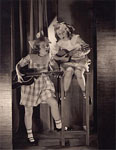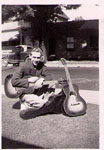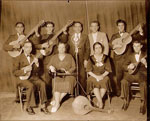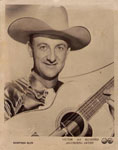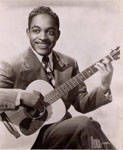Articles
Jan 2009 — A virtual tour through my collection of vintage guitar photographs
In the years that I’ve spent around guitars I’ve gotten into collecting peripheral items related to my favorite instruments as well. Some of the related ephemera that has caught my interest includes collectible paper (like catalogs, dealer items and factory correspondence) and dealer signs and banners. I’ve also developed an interest in early photographs (19th and early/mid 20th century) that feature vintage guitars. While there are plenty of old photos out there that show people posed with instruments not all of the people in such portraits were necessarily guitar players. Photographers sometimes kept instruments in studio (along with other items) to use as props in portraits. I’ve been primarily interested though in portraiture that shows players with name brand instruments that are identifiable. Most of the images that I own feature Martin built guitars, though there are plenty of Gibsons and guitars made by other known makers as well.
I hope you will enjoy this peek into my collection of vintage guitar related images. In each case I’ve attempted to dig up any info that is readily available on the net about any of the subjects who can be identified in the pics.
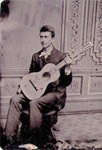 This image is likely from the 4th quarter of the 19th century though tin type photography was available in the US in the late 1850s. The manner of dress and the surroundings of the studio could place it almost any time in the second half of the 19th century. Details of the guitar in the photo cannot be seen clearly enough to definitively attribute the guitar to any one maker. The bridge is definitely a pyramid style and appears to be much the shape and contour of a Martin pyramid bridge of the period. The shape of the guitar looks consistant with Martin proportions, possibly a size 2 or 2 ½.. None of the specs of the appointments of the guitar can be seen. The subject in the photo seems almost to be holding the guitar away from his body, perhaps this man was not a player but using the guitar as a prop as I mentioned previously. Nevertheless it is a clear, interesting and early image.
This image is likely from the 4th quarter of the 19th century though tin type photography was available in the US in the late 1850s. The manner of dress and the surroundings of the studio could place it almost any time in the second half of the 19th century. Details of the guitar in the photo cannot be seen clearly enough to definitively attribute the guitar to any one maker. The bridge is definitely a pyramid style and appears to be much the shape and contour of a Martin pyramid bridge of the period. The shape of the guitar looks consistant with Martin proportions, possibly a size 2 or 2 ½.. None of the specs of the appointments of the guitar can be seen. The subject in the photo seems almost to be holding the guitar away from his body, perhaps this man was not a player but using the guitar as a prop as I mentioned previously. Nevertheless it is a clear, interesting and early image.
In this shot the subject is holding what appears to be a Stauffer style guitar though it is uncertain from the pics whether the guitar might be of Martin origin. There were makers other than Martin building Stauffer inspired guitar that included the distinctive scrolled headstock with all the tuners on the bass side. While the headstock outline cannot be seen in this pic one can see the string posts of the tuners in a diagonal line as was the orientation on Stauffer style Martins. In addition, the European “hourglass” type shape (relatively equal lower and upper bout widths) were common on some very early Martin Stauffer style guitars. The clarity of this image isn’t any help, so it is not possible to make any definitive statement about whether this guitar is of Martin origin or not.
building Stauffer inspired guitar that included the distinctive scrolled headstock with all the tuners on the bass side. While the headstock outline cannot be seen in this pic one can see the string posts of the tuners in a diagonal line as was the orientation on Stauffer style Martins. In addition, the European “hourglass” type shape (relatively equal lower and upper bout widths) were common on some very early Martin Stauffer style guitars. The clarity of this image isn’t any help, so it is not possible to make any definitive statement about whether this guitar is of Martin origin or not.
 This image is in the form of a small cabinet card and is from the late 19th century or very early 20th century. The photograph is marked “Knox Photographer, Athol Depot MA”. At the bottom is written in fine script by hand “Comic Brown and Mr. Haywood” which I assume to be the identities of these two gentlemen. The men in the photo wear matching outfits, their jackets and vests appear to be velvet. A quick internet search reveals nothing in reference to them but perhaps they were a performing duo of some kind. The guitar is, without question, a Martin built instrument however. It appears to be an 0 or 1 size and it has an ivory bridge indicating that it is at least a style 34 and perhaps a 42, though the fretboard does not appear to have any inlay on the fretboard. Close examination also reveals that this guitar has friction pegs. A very formal and very clear image of a 19th century high end Martin.
This image is in the form of a small cabinet card and is from the late 19th century or very early 20th century. The photograph is marked “Knox Photographer, Athol Depot MA”. At the bottom is written in fine script by hand “Comic Brown and Mr. Haywood” which I assume to be the identities of these two gentlemen. The men in the photo wear matching outfits, their jackets and vests appear to be velvet. A quick internet search reveals nothing in reference to them but perhaps they were a performing duo of some kind. The guitar is, without question, a Martin built instrument however. It appears to be an 0 or 1 size and it has an ivory bridge indicating that it is at least a style 34 and perhaps a 42, though the fretboard does not appear to have any inlay on the fretboard. Close examination also reveals that this guitar has friction pegs. A very formal and very clear image of a 19th century high end Martin.
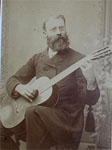
This is one of the first images I purchased when I became interested in this sort of thing. It is a cabinet card photo and shows a 19th century gentleman in formal dress holding what appears to be a Martin 0-28. The bridge details are clear enough to suggest Martin manufacture as are the size and proportions. From the formal playing posture (left knee raised, pinky of the right hand rested on the soundboard with his thumb, index finger, middle finger and ring finger properly placed it is safe to assume he was a player. He has a rather impressive beard as well.
 This cabinet card image is rather small and shows a young boy, perhaps 10 yrs. Old in dress attire with a small guitar. Proportionally and by shape the guitar could be of Martin origin, perhaps a size 2, but it is impossible to tell with any certainty.
This cabinet card image is rather small and shows a young boy, perhaps 10 yrs. Old in dress attire with a small guitar. Proportionally and by shape the guitar could be of Martin origin, perhaps a size 2, but it is impossible to tell with any certainty.
This image shows a young black man seated with a guitar in a relaxed pose. The man is very well dressed and coiffed. The instrument is not of Martin origin but the rarity of 19th century images of black Americans, let alone such a clear image in a studio setting, is what attracted me to the cabinet card.
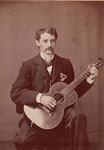 This cabinet card photo shows a well dressed man holding what is definitely a Martin guitar, late 19th century. The body shape and rosette detail are consistent with Martin design and the visible contour detail of the bridge is correct for Martin pyramid shape. The guitar appears to be a size 1 most likely, and there is some visible detail of the top purfling that suggests style 26, but it may also be style 28.
This cabinet card photo shows a well dressed man holding what is definitely a Martin guitar, late 19th century. The body shape and rosette detail are consistent with Martin design and the visible contour detail of the bridge is correct for Martin pyramid shape. The guitar appears to be a size 1 most likely, and there is some visible detail of the top purfling that suggests style 26, but it may also be style 28.
This image shows an unidentified 19th century man holding a very fancy guitar and apparently 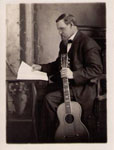 reviewing sheet music. He bears some resemblance to W.G. Bemis, who appears in the 1892 Washburn catalog as an endorsing artist/teacher but I cannot say for sure whether it is Bemis in the photo. The guitar however appears to be a presentation style Washburn with pearl trim on the top and pearl inlays in the neck. The headstock inlay is exactly the same as several presentation grade Washburns I’ve seen (including the one in my Gallery section of the website) and the pyramid bridge with inlays at the ends is sometimes seen on the fanciest Washburns as well. This guitar also appears to be quite large for the time, at least a 00 size if not larger.
reviewing sheet music. He bears some resemblance to W.G. Bemis, who appears in the 1892 Washburn catalog as an endorsing artist/teacher but I cannot say for sure whether it is Bemis in the photo. The guitar however appears to be a presentation style Washburn with pearl trim on the top and pearl inlays in the neck. The headstock inlay is exactly the same as several presentation grade Washburns I’ve seen (including the one in my Gallery section of the website) and the pyramid bridge with inlays at the ends is sometimes seen on the fanciest Washburns as well. This guitar also appears to be quite large for the time, at least a 00 size if not larger.
 This is one of the most interesting images in my collection. The writing on the back of the photo identifies the man as “John Jacob Voorhees circa 1905”. It is a fine, clear image that clearly shows the detail of his suit and the carved chair he is sitting on but more importantly the details of the guitar. It is definitely a Martin and is marked as such on the headstock, even though the photo pre-dates Martin headstock decals (more on that below). The guitar appears to be an 0 size instrument, at least a style 27 as the pearl in the rosette is clear. The top may have pearl trim as well but it is not clear whether the top trim is pearl or marquetry. Some fretboard inlays are visible as well. The most interesting aspect of the guitar is it’s headstock marking, which shows the name “MARTIN” inlaid in pearl across the headstock. Similar headstock inlay is found, according to Washburn and Johnston’s book “Martin Guitars” on some mandolins from the first decade of the 20th century, and the book shows a picture of a 1907 mandolin with this exact headstock inlay. Washburn and Johnston also note that Martin records indicate that two guitars were made with that headstock sometime before that time. I think it is safe to assume that this guitar in the photo is one of those two. If the guitar still survives it should be rather easy to identify by the inlay, and if anyone reading this article has such a guitar I’d be interested in hearing about it.
This is one of the most interesting images in my collection. The writing on the back of the photo identifies the man as “John Jacob Voorhees circa 1905”. It is a fine, clear image that clearly shows the detail of his suit and the carved chair he is sitting on but more importantly the details of the guitar. It is definitely a Martin and is marked as such on the headstock, even though the photo pre-dates Martin headstock decals (more on that below). The guitar appears to be an 0 size instrument, at least a style 27 as the pearl in the rosette is clear. The top may have pearl trim as well but it is not clear whether the top trim is pearl or marquetry. Some fretboard inlays are visible as well. The most interesting aspect of the guitar is it’s headstock marking, which shows the name “MARTIN” inlaid in pearl across the headstock. Similar headstock inlay is found, according to Washburn and Johnston’s book “Martin Guitars” on some mandolins from the first decade of the 20th century, and the book shows a picture of a 1907 mandolin with this exact headstock inlay. Washburn and Johnston also note that Martin records indicate that two guitars were made with that headstock sometime before that time. I think it is safe to assume that this guitar in the photo is one of those two. If the guitar still survives it should be rather easy to identify by the inlay, and if anyone reading this article has such a guitar I’d be interested in hearing about it.
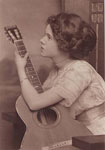 These four photos are of Vadah Olcott-Bickford. Bickford was an accomplished concert guitarist and teacher who endorsed Martin guitars and
These four photos are of Vadah Olcott-Bickford. Bickford was an accomplished concert guitarist and teacher who endorsed Martin guitars and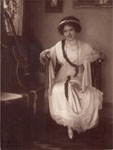 was the founder of the American Guitar Society and director of the American Guitar Society Orchestra. She was particularly fond of the highest quality Martin guitars but preferred simple ornamentation. In order to satisfy her taste Martin introduced the style 44 Olcott-Bickford artist guitar which featured the highest grade materials but none of the pearl appointments common to style 40, 42 and 45 guitars. It is estimated that about 35 style 44 guitars were made in the various sizes that were offered.These pictures show several Olcott-Bickford at several
was the founder of the American Guitar Society and director of the American Guitar Society Orchestra. She was particularly fond of the highest quality Martin guitars but preferred simple ornamentation. In order to satisfy her taste Martin introduced the style 44 Olcott-Bickford artist guitar which featured the highest grade materials but none of the pearl appointments common to style 40, 42 and 45 guitars. It is estimated that about 35 style 44 guitars were made in the various sizes that were offered.These pictures show several Olcott-Bickford at several 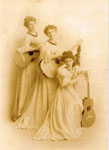 stages of her career spanning from shots that show her as quite young indeed (perhaps still a teen ager, as she was a child prodigy). The first shot shows a very young Bickford with a Martin that appears to be at least 00 in size and style 45. The second shot again shows a very young Bickford seated with a Martin guitar propped in a seat next to her. There is not enough detail available in the pic to determine the style of the guitar, but it appears to be an 0 size and it has friction pegs. It is known that Bickford had a friction peg 0-28 that she played throughout her life (it is visible in one of the other pics posted
stages of her career spanning from shots that show her as quite young indeed (perhaps still a teen ager, as she was a child prodigy). The first shot shows a very young Bickford with a Martin that appears to be at least 00 in size and style 45. The second shot again shows a very young Bickford seated with a Martin guitar propped in a seat next to her. There is not enough detail available in the pic to determine the style of the guitar, but it appears to be an 0 size and it has friction pegs. It is known that Bickford had a friction peg 0-28 that she played throughout her life (it is visible in one of the other pics posted 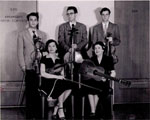 here) and perhaps this is that guitar. The third pic shows Bickford with her La Banduria Trio, probably from the 1920s. Note the elegant dress of the trio and the fact that all three guitars are Martins of at least style 42. The final pic of Bickford shows her later in life with an unidentified group of musicians, probably from the 60s or early 70s. Bickford, the only guitarist in the photo, is seen with her 19th century Martin 0-28 with the friction pegs, perhaps the same guitar as is seen in photo #2.
here) and perhaps this is that guitar. The third pic shows Bickford with her La Banduria Trio, probably from the 1920s. Note the elegant dress of the trio and the fact that all three guitars are Martins of at least style 42. The final pic of Bickford shows her later in life with an unidentified group of musicians, probably from the 60s or early 70s. Bickford, the only guitarist in the photo, is seen with her 19th century Martin 0-28 with the friction pegs, perhaps the same guitar as is seen in photo #2.
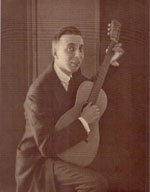 This photo came to me in the same purchase as the Olcott-Bickford pictures (they were all purchased from the niece of Bickford). The photo shows a man identified as Edmund Homer Royce who is posed with a Martin guitar that is likely a 00-28 (style 28 is definite, size looks like 00 but could be 0 as well). The image is clear and the guitar prominently featured in the shot, a nice image all around. The back is inscribed “To Mr. and Mrs. Bickford, wonderful artists, delightful friends, from their very sincere admirer, Edmund Homer Royce” I do not know if this is the same Edmund Homer Royce of St. Albans VT who earned fame in the 1930s for his photographic documentation of Vermont’s covered bridges, but I’d be interested to find out if anyone knows.
This photo came to me in the same purchase as the Olcott-Bickford pictures (they were all purchased from the niece of Bickford). The photo shows a man identified as Edmund Homer Royce who is posed with a Martin guitar that is likely a 00-28 (style 28 is definite, size looks like 00 but could be 0 as well). The image is clear and the guitar prominently featured in the shot, a nice image all around. The back is inscribed “To Mr. and Mrs. Bickford, wonderful artists, delightful friends, from their very sincere admirer, Edmund Homer Royce” I do not know if this is the same Edmund Homer Royce of St. Albans VT who earned fame in the 1930s for his photographic documentation of Vermont’s covered bridges, but I’d be interested to find out if anyone knows.
This pair of photos shows the Duncan Sisters (Rosetta, 1894-1959 and Vivian, 1897-1986) in stage attire with their Martin guitars. The Duncan sisters were a successful vaudeville act of music and comedy. They wrote 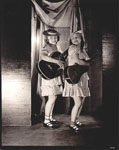 much of their own material and toured doing theaters, clubs, Broadway and eventually MGM movies. They were a great hit as “Topsy and Eva”, a pairof characters suggested by Uncle Tom’s Cabin. In this pair of photos theyare shown with a pair of very rare and interesting Martin instruments. Both instruments have the distinctive shape of the guitars build by Martin for theOliver Ditson Co. starting in 1916. The dark topped guitar (the larger of
much of their own material and toured doing theaters, clubs, Broadway and eventually MGM movies. They were a great hit as “Topsy and Eva”, a pairof characters suggested by Uncle Tom’s Cabin. In this pair of photos theyare shown with a pair of very rare and interesting Martin instruments. Both instruments have the distinctive shape of the guitars build by Martin for theOliver Ditson Co. starting in 1916. The dark topped guitar (the larger of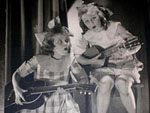 the two) is likely the style 33, that being a mahogany bodied guitar with spruce top that was stained dark brown according to specs laid out by Longworth, and the middle of the three sizes offered. The other guitar is the smallest of the Ditsons and in style 45, the model designation being the 1-45. Only 4 of these guitars were made. These shots are particularly nice in that the guitars are clearly visible in good detail and they are some of the most interesting guitars Martin has ever made.
the two) is likely the style 33, that being a mahogany bodied guitar with spruce top that was stained dark brown according to specs laid out by Longworth, and the middle of the three sizes offered. The other guitar is the smallest of the Ditsons and in style 45, the model designation being the 1-45. Only 4 of these guitars were made. These shots are particularly nice in that the guitars are clearly visible in good detail and they are some of the most interesting guitars Martin has ever made.
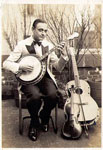 The guitar in this fine, sharp image is as rare and interesting as the Ditsons in the Duncan Sistersphotos. It is a Martin built Paramount style L. Around 1930 Martin was contracted to build a line of guitars that had tone similar to the banjo. Some of the guitars were tenors and some had 6 strings. This one differs from the few others I’ve seen in some of the vintage guitar resource books in that it has a round soundhole like a standard flat top and a fixed bridge (most of the other style L guitars have a moveable bridge and tailpiece like an archtop. It’s appeal with banjo players is likely confirmed by this photo which shows the owner of the guitar playing a tenor banjo next to the guitar. The man is well dressed and likely was a professional or semi-professional musician.
The guitar in this fine, sharp image is as rare and interesting as the Ditsons in the Duncan Sistersphotos. It is a Martin built Paramount style L. Around 1930 Martin was contracted to build a line of guitars that had tone similar to the banjo. Some of the guitars were tenors and some had 6 strings. This one differs from the few others I’ve seen in some of the vintage guitar resource books in that it has a round soundhole like a standard flat top and a fixed bridge (most of the other style L guitars have a moveable bridge and tailpiece like an archtop. It’s appeal with banjo players is likely confirmed by this photo which shows the owner of the guitar playing a tenor banjo next to the guitar. The man is well dressed and likely was a professional or semi-professional musician.
This group looks like they might have just finished a gig, or maybe  this shot was taken on the steps on their way into the gig. The guitars visible in the photo are a Martin 000-18 and a Gibson Nick Lucas flat top. Note that the portrait of Nick Lucas on the Gibson label is visible through the soundhole of the guitar in this picture. There is also an archtop visible on the extreme left which appears to be maybe a Gibson or Epiphone of some description. Looks like they are having fun.
this shot was taken on the steps on their way into the gig. The guitars visible in the photo are a Martin 000-18 and a Gibson Nick Lucas flat top. Note that the portrait of Nick Lucas on the Gibson label is visible through the soundhole of the guitar in this picture. There is also an archtop visible on the extreme left which appears to be maybe a Gibson or Epiphone of some description. Looks like they are having fun.
This pic shows a group of four guys with three guitars between them. On the back of the photo they are identified as “The Boys, KFH, DeCoursey Cream Co., Wichita”. On the front the four are identifiedas Ralph, Earl, Gene and Herb. Gene (back row) holds what appears to be a Martin 00-18. Herb (seated, right) sports a 12 fret Gibson mahogany topped (late 20s/early 30s) L-0. Ralph (seated, left) has a Martin Hawaiian model on his lap. Though the top purfling nor the fretboard inlays are visible the white binding on top and back strongly suggest that it is a 00-40H and the straight bridge on the guitar suggests that it is from the 1920s as opposed to the 30s. Most likely these fellows played a show on radio KFH in Wichita that was sponsored by the DeCoursey Cream Co.
identifiedas Ralph, Earl, Gene and Herb. Gene (back row) holds what appears to be a Martin 00-18. Herb (seated, right) sports a 12 fret Gibson mahogany topped (late 20s/early 30s) L-0. Ralph (seated, left) has a Martin Hawaiian model on his lap. Though the top purfling nor the fretboard inlays are visible the white binding on top and back strongly suggest that it is a 00-40H and the straight bridge on the guitar suggests that it is from the 1920s as opposed to the 30s. Most likely these fellows played a show on radio KFH in Wichita that was sponsored by the DeCoursey Cream Co.
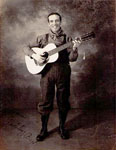 I haven’t had any luck finding out anything about Yodeling Bart, identified in this picture and looking like a railroad man. The popularity of Jimmy Rogers gave rise to a lot of imitators and our Bart was probably one. The image is excellent in it’s clarity and shows Bart with a Martin 00-21. This image is probably from the middle 1930s.
I haven’t had any luck finding out anything about Yodeling Bart, identified in this picture and looking like a railroad man. The popularity of Jimmy Rogers gave rise to a lot of imitators and our Bart was probably one. The image is excellent in it’s clarity and shows Bart with a Martin 00-21. This image is probably from the middle 1930s.
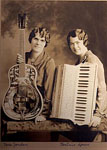
I haven’t found any info on this pair either…but theimage is a good one. They are identified as Nora Jordan and Beatrice Spies. The guitar shown is a very fancy National style 0 guitar. The clarity of the image gives a great look at the etched (sand blasted?) hawaiian motif of decoration. The guitar is late 20s judging from the ‘reverse gear’ orientation of the tuners, so perhaps the photo is late 20s as well as the guitar looks pristine-new.
This shot is unusual in my collection in that the player doesn’t seem to be paying any attention to the photographer, he’s actually playing the guitar rather than posing with it. The guitar shown appears to be a 1930s Gibson L-0 or L-00, can’t be certain which.
These two photos were purchased separately, at different times, from different ebay sellers in two different locations not even close to one another. Yet they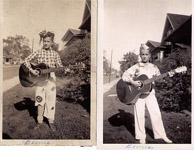 show the same boy, identified on each photo only as “Bernie”. In both pictures the boy, who appears to be about the same age in each shot, stands in front of the same house with what appears to be the same 1930s Gibson L-0 or L-00. Oddly, he is in “costume” in both shots. One pic shows him in some sort of sailor type outfit and the other in a patchwork rag-tagoutfit with an odd hat. Judging from his age in the picture he could well still be alive…I wonder if he’s still got the guitar…
show the same boy, identified on each photo only as “Bernie”. In both pictures the boy, who appears to be about the same age in each shot, stands in front of the same house with what appears to be the same 1930s Gibson L-0 or L-00. Oddly, he is in “costume” in both shots. One pic shows him in some sort of sailor type outfit and the other in a patchwork rag-tagoutfit with an odd hat. Judging from his age in the picture he could well still be alive…I wonder if he’s still got the guitar…
The subject in this photo certainly appears proud of the two guitars he holds in the pose. The guitar on his lap is a Kalamazoo KG-14, the ladder braced K’zoo version of the Gibson L-00. The outline of the “rooftop” style headstock can be seen and the “Kalamazoo” silk screened logo is visible. The guitar leaning to his left is a Gibson L-00 with a 12 fret neck. The size of the burst suggests that the guitar (and photo) are likely ’36 or later.
This photo shows an ensemble with several identifiable instruments. From the left (back) the first guitar is not known to me, a flat top but with a headstock logo that may be Epiphone or some other maker with a banner style logo. To his right is a fellow playing what appears to be a Gibson L-00 with a very small sunburst and a 12 fret neck. On the far right the guitar player has a Martin 000-18 12 fretter. The mandolinist in front of him (front row right side) is playing a Martin A style mandolin. The woman seated next to the mandolin player looks truly happy to be there, don’t you think?
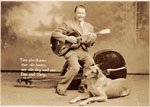 If it were just the Gibson archtop tenor guitar in this photo I probablywould not have bought it. However, I’m a major dog lover and the addition of old Shep to the photo made this one attractive to me…The dog appears to be a great dane. I’ve not been able to find any info on this entertainer but I assume that he may have been a radio show personality.
If it were just the Gibson archtop tenor guitar in this photo I probablywould not have bought it. However, I’m a major dog lover and the addition of old Shep to the photo made this one attractive to me…The dog appears to be a great dane. I’ve not been able to find any info on this entertainer but I assume that he may have been a radio show personality.
Montana Slim is identified on the photo as a Victor and Bluebird Recording Artist. His real name was Wilfred Carter. He was born in Canada and was widely popular as a singer and yodeler, he spent a few years in NYC as a radio cowboy singer. He was Canada’s first country music star and is considered the father of Canadian Country Music. He is shown in the shot holding a Martin 000-42, or perhaps a style 45, not enough of the guitar is visible to make a clear determination.
 This post card photo shows Smiley (Roy) Maxedon with a pre-war Martin D-45. The little I can find on the web about him suggests that his recording took place in the 50s but this photo looks earlier than that, perhaps 1940s.
This post card photo shows Smiley (Roy) Maxedon with a pre-war Martin D-45. The little I can find on the web about him suggests that his recording took place in the 50s but this photo looks earlier than that, perhaps 1940s. 
This is a fine image shows a woman identified as “Betty Lou” in cowgirl garb holding a Martin 000-18. I am guessing that this image is from the 1930s or early 40s.
 This 1930s image shows a player dressed in cowboy garb holding a Martin, most likely an OM-28. The small teardrop pickguard evident on the guitar pegs it as an OM most likely, and the light binding that is visible indicates it was at least a style 28 or possibly a pearl model. The photo is inscribed “For Betty Neville: may all creatures have as good a sense of humor-Winston O’Keefe.” I’ve not found any info online about this performer.
This 1930s image shows a player dressed in cowboy garb holding a Martin, most likely an OM-28. The small teardrop pickguard evident on the guitar pegs it as an OM most likely, and the light binding that is visible indicates it was at least a style 28 or possibly a pearl model. The photo is inscribed “For Betty Neville: may all creatures have as good a sense of humor-Winston O’Keefe.” I’ve not found any info online about this performer.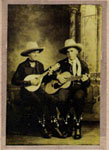
This is a nice image. The pair in the photo is dressed in matching cowboy outfits but the person on the left appears to be a woman. She is playing a Martin A style mandolin. The man on the right is playing what appears to be a Martin 00-42 or 45 12 fretter. Not enough detail of the instrument is visible to determine the style but it is at least a 42.
 This group was first formed in 1931 with Bob Wills, Milton Brown andW. Lee O’Daniel as part of the ensemble. They received their name as pitch men for a flour mill. I do not know exactly when this photo was taken but I would guess post-war, maybe the 50s. They are identified on the card as Zeke, Bashful, Abner, Doctor, Parker Willson (announcer), Krocky, Snub and Junior (left to right). Zeke (on the far left) holds a Martin D-28 guitar. The back of the card reads “here’s a picture of your friends of the air---The Light Crust Doughboys—who always appreciate your interest in their programs. On the air at 12:30 noon”
This group was first formed in 1931 with Bob Wills, Milton Brown andW. Lee O’Daniel as part of the ensemble. They received their name as pitch men for a flour mill. I do not know exactly when this photo was taken but I would guess post-war, maybe the 50s. They are identified on the card as Zeke, Bashful, Abner, Doctor, Parker Willson (announcer), Krocky, Snub and Junior (left to right). Zeke (on the far left) holds a Martin D-28 guitar. The back of the card reads “here’s a picture of your friends of the air---The Light Crust Doughboys—who always appreciate your interest in their programs. On the air at 12:30 noon”

This photo, used in the Washburn and Johnston book “Martin Guitars, An Illustrated History of America’s Premier Guitarmaker”, shows a performer identified only as “Vonny” holding her Martin D-18. The pic is probably from the 1940s. She is posed in front of a microphone as was common for radio show performers.
 The trio in this photo are posed with a microphone that reads “WPEN” though none of the three are identified. WPEN is a Philly area station. The girl seated in the photo is playing a Martin 0-18 or 00-18 guitar, which size it is isn’t clear in the photo but it’s no bigger than a 00. The straight bridge on this guitar would suggest that the instrument is 1929 or earlier, as it was in ’29 that Martin went to a belly style bridge on virtually all their models. However, the photo looks to be later, perhaps 30s or 40s.
The trio in this photo are posed with a microphone that reads “WPEN” though none of the three are identified. WPEN is a Philly area station. The girl seated in the photo is playing a Martin 0-18 or 00-18 guitar, which size it is isn’t clear in the photo but it’s no bigger than a 00. The straight bridge on this guitar would suggest that the instrument is 1929 or earlier, as it was in ’29 that Martin went to a belly style bridge on virtually all their models. However, the photo looks to be later, perhaps 30s or 40s.
This photo shows a pair of sharp-dressed men in front of a radio microphone with the call letters “KMMJ”. The station is from Grand Island, Nebraska and today has a Christian radio format but who knows what these fellows played. The instruments played are (on the left) a Gibson archtop tenor electric guitar and (on the right) a Martin 00-18. If you are from New York State you’ll likely recognize the resemblance of the man on the right to the speaker of the NYS House of Representatives, Sheldon Silver. Perhaps this was his previous professional incarnation….
I find nothing on the web when searching for Irvine Burgess. I think this picture is likely from the late 40s or 1950s and the shot shows Burgess with a Martin 00-18. From the swirl pattern and general light color of the pickguard I would guess that the instrument is from the 1940s.
